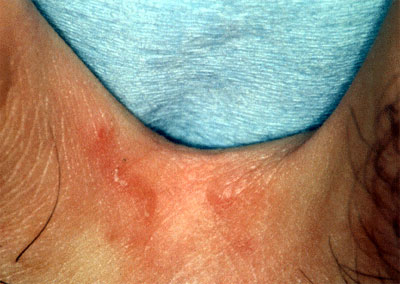|
|
|
Scabies
Human scabies is caused by Sarcoptes scabiei. This mite is passed from person to person. The mite lives on dead keratinized skin.
Areas of frequent clinical involvement are the finger webs, lateral aspects of the hands, wrists, axillae, and penis.
Burrows can frequently be seen. Scraping of these burrows or the associated small pustules, on examination under oil, will typically show the mite, mite feces, or egg cases.
Generalized scabies with many thousands of organisms can be found in immune compromised individuals, the so-called Norwegian scabies.
Scabies in children can provoke a bullous response. Areas above the neck are spared except in small children and individuals with Norwegian scabies.
Treatment:
- The application of gamma benzene hexachloride or pyrethrin cream to the body below the neck is the treatment of choice for older children and adults. This cream is applied overnight with care being taken to cover every part of the skin below the neck. A repeated treatment in one week is advisable.
- Close personal contact should be treated at the same time.
- The patient should be advised that the pruritus does not decrease for typically 2 to 4 weeks, as the pruritus is caused by a host immune response against the mite and mite parts. The pruritus abates when the last dead mites are shed from the skin surface.
- Because of increased percutaneous absorption of the toxic chemicals in infants, gammabenzene hexachloride or pyrethrin are not usually used in deference to 10% sulfur ointment daily for one week.
- Care should be taken to examine the infant for evidence of scabies above the neck as, unlike adults, the entire skin surface is vulnerable to scabies.
- Permethrin 5% cream
- Malathion .5% lotion

Back to Dermatology Glossary - S Index |
Back to Dermatology Glossary Index
|